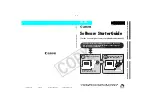
661
ADOBE PHOTOSHOP CS2
User Guide
Compression and downsampling options for Adobe PDF
When saving artwork in Adobe PDF, you can compress text and line art, and compress and downsample bitmap
images. Depending on the settings you choose, compression and downsampling can significantly reduce the size of
a PDF file with little or no loss of detail and precision.
The Compression area of the Adobe PDF Options dialog box is divided into three sections. Each section provides
the following options for compressing and resampling color, grayscale, or monochrome images in your artwork.
Downsampling
If you plan to use the PDF file on the web, use downsampling to allow for higher compression. If
you plan to print the PDF file at high resolution, do not use downsampling. Deselect the option to disable all
downsampling options.
Downsampling
refers to decreasing the number of pixels in an image. To downsample color, grayscale, or
monochrome images, choose an
interpolation method
—average downsampling, bicubic downsampling, or subsam-
pling—and enter the desired resolution (in pixels per inch). Then enter a resolution in the For Images Above text
box. All images with resolution above this threshold are downsampled.
The interpolation method you choose determines how pixels are deleted:
•
Average Downsampling
Averages the pixels in a sample area and replaces the entire area with the average pixel
color at the specified resolution. Average downsampling is the same as Bilinear resampling.
•
Bicubic Downsampling
Uses a weighted average to determine pixel color, which usually yields better results than
the simple averaging method of downsampling. Bicubic is the slowest but most precise method, resulting in the
smoothest gradations.
•
Subsampling
Chooses a pixel in the center of the sample area and replaces the entire area with that pixel color.
Subsampling significantly reduces the conversion time compared with downsampling but results in images that are
less smooth and continuous. Subsampling is the same as Nearest Neighbor resampling.
Compression
Determines the type of compression that is used. The Automatic option automatically sets the best
possible compression and quality for the artwork contained in the file. For most files, this option produces satis
factory results. Use Automatic (JPEG) if you need the greatest compatibility.
•
ZIP compression
Works well on images with large areas of single colors or repeating patterns, and for black-and-
white images that contain repeating patterns. ZIP compression can be lossless or lossy, depending on the Quality
setting.
•
JPEG compression
Is suitable for grayscale or color images. JPEG compression is
lossy
, which means that it
removes image data and may reduce image quality; however, it attempts to reduce file size with a minimal loss of
information. Because JPEG compression eliminates data, it can achieve much smaller file sizes than ZIP
compression.
•
JPEG2000
Is the new international standard for the compression and packaging of image data. Like JPEG
compression, JPEG2000 compression is suitable for grayscale or color images. It also provides additional advantages,
such as progressive display.
•
CCITT and Run Length compression
Are available only for monochrome bitmap images. CCITT (Consultative
Committee on International Telegraphy and Telephony) compression is appropriate for black-and-white images and
any images scanned with an image depth of 1 bit. Group 4 is a general-purpose method that produces good
compression for most monochrome images. Group 3, used by most fax machines, compresses monochrome bitmaps
one row at a time. Run Length compression produces the best results for images that contain large areas of solid black
or solid white.
Image Quality
Determines the amount of compression that is applied. The available options depend on the
compression method. For JPEG Compression, Photoshop provides Minimum, Low, Medium, High, and Maximum















































